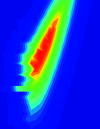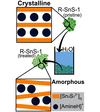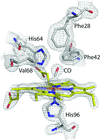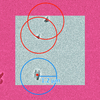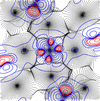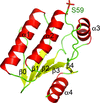issue contents
September 2019 issue

editorial
NEUTRON | SYNCHROTRON
With the technological development of affordable and impactful laboratory-based tools and their ever-growing scientific scope, large-science facilities need to review their strategies in order to continue to add value for their scientific communities.
scientific commentaries
MATERIALS | COMPUTATION
Oligocrystalline-structured Ni43.7Cu1.5Co5.1Mn36.7In13 microwires with bamboo-like grains were successfully prepared by Chen et al. [(2019), IUCrJ, 6, 843–853]. Pronounced mechanical and magnetic properties were shown in the tensile superelasticity and the magnetocaloric effect, respectively.
highlights
CHEMISTRY | CRYSTENG
A Special Issue on the topic of Electron Crystallography, now available in the August 2019 issue of Acta Crystallographica, Section B, contains contributions which we hope will interest readers of IUCrJ.
topical reviews
CHEMISTRY | CRYSTENG
This is a perspective overview of the opportunities and challenges encountered when working at the interface of chemical (CX) and macromolecular crystallography (MX) as a result of differences in file formats and nomenclature between these sister disciplines. It utilizes the two premier databases in crystallography, the Cambridge Structural Database and Protein Data Bank in the research and development of pharmaceutical and medical imaging agents, the latter being of specific interest to the authors. The interdisciplinary obstacles between CX and MX, where data should be FAIR, i.e. findable, accessible and interoperable and reusable, are specified.
research letters
NEUTRON | SYNCHROTRON
How to optimize experimental setups to make BioXPCS measurements feasible at new generation synchrotron sources.
research papers
MATERIALS | COMPUTATION
The amorphization of semiconducting two-dimensional thiostannates was studied using X-ray total scattering and pair distribution function analysis. The local structure and light absorption properties are retained, while the amorphization is associated with disorder of the thiostannate nanosheet stacking.
CRYO | EM
Download citation


Download citation


The structure of a common virulence factor expressed on the surface of diarrhea-causing bacteria, CFA/I pili, has been determined at 4.3 Å resolution. The role of Pro13 in stabilizing the pilus structure has been investigated using force-measuring optical tweezers on wild-type and point-mutated pili.
EMDB reference: CFA/I pilus rod, EMD-0497
PDB reference: CFA/I pilus rod, 6nrv
NEUTRON | SYNCHROTRON
The automatic processing of over 56 000 crystals by the autonomous ESRF beamline MASSIF-1 has provided a data set of crystal characteristics and properties that allows many theoretical proposals and assumptions to be evaluated experimentally.
BIOLOGY | MEDICINE
Ligand pathways in neuroglobin revealed by low-temperature photodissociation and docking experiments
Ultralow-temperature X-ray crystallography, in crystallo microspectroscopy and X-ray absorption spectroscopy were used to study the carbon monoxide photodissociation intermediate in neuroglobin. Moreover, X-ray crystallography under high O2 pressure allowed the identification of a novel storage site for dioxygen in hexacoordinate ferric neuroglobin.
MATERIALS | COMPUTATION
An Ni–Cu–Co–Mn–In microwire that simultaneously exhibits a magnetic field-induced first-order magnetostructural transition (between the monoclinic six-layered modulated martensite and the cubic austenite) and huge tensile superelasticity has been developed. The huge tensile superelasticity is in agreement with theoretical calculations based on the crystal structure and lattice correspondence of austenite and martensite and the crystallographic orientation of the grains.
MATERIALS | COMPUTATION
Download citation


Download citation


Serial rotation electron diffraction enables fully automated screening and data acquisition on submicrometre-sized crystals using the continuous rotation method via combined image processing and control of the transmission electron microscopy hardware. A data processing pipeline revolving around hierarchical cluster analysis deals with the large multi-crystal data set for phase analysis and structure determination.
MATERIALS | COMPUTATION
Download citation


Download citation


Two methods of high-resolution X-ray data refinement, multipole refinement and Hirshfeld atom refinement together with X-ray wavefunction refinement are compared using data sets collected for the crystals of four quinoline derivatives containing Cl, Br and I atoms and the -S-Ph group. This study highlights the importance of including the full set of reflections in the refinement to facilitate the correct interpretation of the results, which is shown using the example of anharmonic thermal motion refinement.
CCDC references: 1935133; 1935134; 1935135; 1935136; 1935137; 1935138; 1935139; 1935140; 1935141; 1935142; 1935143; 1935144; 1935145; 1935146; 1935147; 1935148; 1935149; 1935150; 1935151; 1935152; 1935153; 1935154; 1935155; 1935156; 1935157; 1935158; 1935159; 1935160; 1935161; 1935162; 1935163; 1935164; 1935165; 1935166; 1935167; 1935168; 1935169; 1935170; 1935171; 1935172; 1935173; 1935174
PHYSICS | FELS
The first joint refinement against X-ray and polarized neutron diffraction data performed to simultaneously model the charge and spin density of the perovskite YTiO3 in its ferromagnetic state is presented. The resulting model confirms the orbital ordering at low temperature.
CHEMISTRY | CRYSTENG
Download citation


Download citation


A three part paper on charge density analysis of actinide containing compounds is presented that covers experimental protocols, augmented multipole model building and a comparison of topological analysis of experimental and theoretical electron densities.
MATERIALS | COMPUTATION
The crystallographic features associated with the martensitic transformation from austenite to seven-layered modulated (7M) martensite in Ni–Mn–Ga ferromagnetic shape-memory alloys have been investigated through electron backscatter diffraction (EBSD) measurements.
CRYO | EM
Download citation


Download citation


MicroED data can be collected with the fastest and most sensitive cameras that are typically reserved for single-particle electron microscopy.
PHYSICS | FELS
1 kHz fixed-target serial crystallography using polychromatic X-rays and a novel JUNGFRAU detector allows the recording of a complete diffraction dataset in 30 s.
PDB references: lysozyme, 5 µs exposure, 750 patterns merged, 6qy2; lysozyme, 5 µs exposure, 1 500 patterns merged, 6qy1; lysozyme, 5 µs exposure, 24 344 patterns merged (3 chips), 6qxw; Proteinase K, 1 µs exposure, 1 585 patterns merged (2 chips), 6qxv; lysozyme, 1 µs exposure, 14 793 patterns merged, 6qy4; lysozyme, 5 µs exposure, 3 000 patterns merged, 6qy0
BIOLOGY | MEDICINE
Stressosome assembly mediated by the STAS domain was analyzed based on the crystal structure of RsbS and the cryo-EM structure of the RsbS–RsbRA complex.
PDB reference: RsbS, 6jhk
BIOLOGY | MEDICINE
The anti-apoptotic multidomain protein XIAP is shown to be a compact dimer in solution as determined by an integrative approach combining NMR, SAXS, EPR and molecular modelling.
SASBDB reference: X-chromosome-linked inhibitor of apoptosis protein, SASDF24
BIOLOGY | MEDICINE
The ternary complex structure of human aspartyl-tRNA synthetase (DRS) and two glutathione S-transferase domains from aminoacyl-tRNA synthase complex-interacting multifunctional protein 2 and glutamyl-prolyl-tRNA synthetase (AIMP2GST and EPRSGST, respectively) was determined at 3.6 Å resolution, providing insight into the pivotal role of the ternary complex within the multi-tRNA synthetase complex.
CHEMISTRY | CRYSTENG
Small-angle X-ray scattering in real polymer systems arises largely from the scattering induced by the evanescent wave. Evidence for the existence of the evanescent wave has been identified in the scattering from isotactic polypropylene.



 journal menu
journal menu




 access
access







